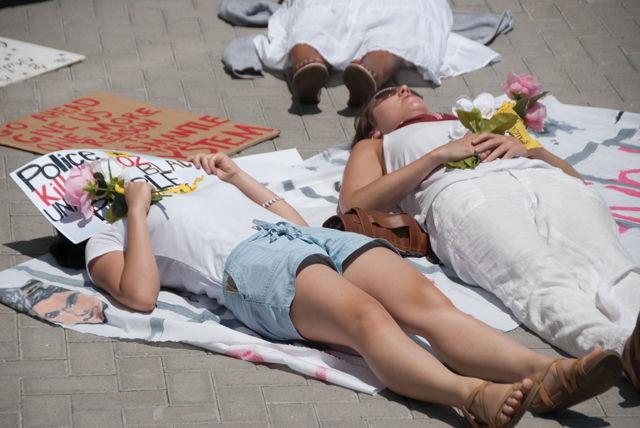 " />
" />
Gabe DeCaro
Protesters stage a "die-in" by lying down for several minutes on the hot bricks in front of the Administration Building. The demonstration paid respect by representing the losses from police killings.
More than 30 people gathered outside the Executive Mansion on Friday, July 8, to protest House Bill 972 and urge Gov. Pat McCrory to veto the bill by delivering a petition with more than 3,000 signatures. Risuin Ksor, a Bonner Scholar at Guilford College, was among the first protesters to arrive across the street from the Executive Mansion. He is affiliated with the Southeast Asian Coalition, the primary organizer of the event, and said, “I feel like a part of history.”
SEAC, 18 Million Rising and the American Civil Liberties Union collaborated to gather the signatures for the petition while organizations like Black Lives Matter, Seeding Change, Democracy NC and the Queer People of Color Consortium joined in for the demonstration. Outside the Executive Mansion, several protest organizers and participants spoke about the motivations for opposing HB 972, particularly in light of the shootings of Alton Sterling, Philando Castile and the five police officers in Dallas.
Tay Morris, a high school student with SEAC, read a list of the names of unarmed people killed by police or in police custody, including Michael Brown, Freddie Gray, Sandra Bland and Alton Sterling. Kass Ottley, representing the Charlotte chapters of Black Lives Matter and Seeking Justice Consortium, spoke about holding public officials accountable for their actions.
“If you don’t weed out the bad, then you’re condoning what they’re doing,” Ottley said. “We vote these people in, we pay their salaries and they’re killing us.”
HB 972 would establish that body and dashboard camera footage are not public record and it would allow law enforcement agencies to withhold these recordings at their discretion. If a law enforcement agency refuses to release footage, then a Superior Court judge could order a release of the recordings “if the court finds that the law enforcement agency abused its discretion.”
“We need police accountability; we need to be able to have access to body cam and dashcam video from the public servants,” said Tai Little, a volunteer with SEAC. “They’re supposed to be there to serve and protect us. They need to answer questions when we have them.”
An open mic was offered to the crowd of protesters and Morris spoke again about the fear felt in her community.
“My brother likes to go outside and ride his bike, and every time, I have to think about whether a police officer is going to knock on my door and tell my mother that a police officer has killed her son,” Morris said. “Nobody has to feel our pain, yet they can inflict it.”
After the demonstration in front of the Executive Mansion, the crowd then began to march to the Administration building, two blocks away, chanting “Hey hey, ho ho, police brutality’s got to go,” “No justice for the browns, no justice for the blacks, stand up fight back” and “Black lives matter.”
Upon arriving in front of the Administration building, protesters staged a “die-in” demonstration, lying on the hot bricks for several minutes to represent the victims of police killings. After, the youth members of SEAC delivered the petition along with 77 flowers with the names of those killed in North Carolina by police since the implementation of body cameras to Alicia Johnson, constituent outreach director for McCrory.
Cat Bao Le, the executive director of Charlotte’s chapter of SEAC, explained the group’s presence in protesting HB 972.
“The context of our lives here is intricately tied to other communities that have overlapping needs,” Le said. “We’re not an isolated community … This particular fight [against HB 972] started when one of our mentally ill Vietnamese community members, Chieu Di Thi Vo, was shot and killed by Greensboro police, and it was the first time an officer in North Carolina was carrying a body camera.”
Le explained that many issues that affect black communities also affect Asian and Latin American groups, such as poverty, deportations, low high school graduation rates and discrimination. This theme of intersectionality has played a large part in SEAC’s organization and demonstrations, and Le said that she views marginalized groups with a common problem.
“I learned about the Greensboro sit-ins at a young age,” Le said. “I always saw North Carolina as the beacon of the civil rights movement. When I see North Carolina going back on a number of those rights that have been fought, it’s really disturbing.”